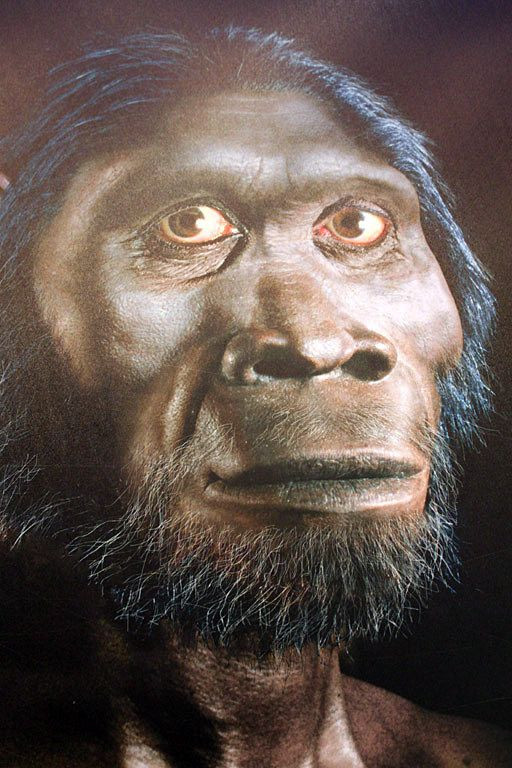On The Way To Humanity, Hominids Changed Diet 3.5 Million Years Ago

Some 3.5 million years ago, a seminal moment occurred in the evolutionary history of hominids. While it may have been less dramatic than the obelisk from Stanley Kubrick's 2001: A Space Odyssey or the devastating meteorite that may have cleared the earth of dinosaurs, it was an essential step toward humanity.
Ancient African hominids started eating grass.
Before then, Africa's hominids ate a diet similar to chimpanzees, probably consuming fruits and some leaves, Matt Sponheimer, an anthropologist at the University of Colorado, Boulder, told reporters on Monday. In one of three new related studies published in the Proceedings of the National Academy of Sciences, he and his colleagues used advanced tools to test tooth enamel from fossils of animals living millions of years ago — finding that hominids suddenly started added grasses and sedges to their diet.
"We don't know exactly what happened," Sponheimer said. "But we do know that after about 3.5 million years ago, some of these hominids started to eat things that they did not eat before, and it is quite possible that these changes in diet were an important step in becoming human."
Previous studies had analyzed the teeth of 87 ancient hominid specimens. In comparison, today's trilogy in Proceedings reports enamel analysis of an additional 88 specimens, including five from previously unanalyzed species, doubling the amount of data on the subject. Specializing in stable isotope analysis, Sponheimer compared particular forms of chemical elements, such as carbon, found in teeth fossils from ancient hominids. Microscopic wear on the teeth enamel is enough to allow scientists to glean which types of plants the animals were eating.
Carbon from the teeth derives from two distinct pathways of photosynthesis, Sponheimer said. Whereas one comes from trees and bushes, another derives specifically from grasses and sedges. A few million years ago, hominids from the genus Homo that evolved from australopithecines — considered to be a precursor to modern humans — were broadening their diet.
At the same time, a contemporary upright hominid known as Paranthropus boisei, co-existing with the Homo genus in eastern Africa, diverged toward a more restricted diet of grasses and sedges. Previously known by the moniker, "Nutcracker Man," for his large, flat teeth, and powerful jaws, recent study suggests the animal might have used its back teeth to grind grasses and sedges, the researcher said.
"We now have the first direct evidence that as the cheek teeth on hominids got bigger, their consumption of plants like grasses and sedges increased," he said. "We also see niche differentiation between Homo and Paranthropus — it looks probable that Paranthropus boisei had a relatively restricted diet, while members of the genus Homo were eating a wider variety of things.
"The genus Paranthropus went extinct about 1 million years ago, while the genus Homo that includes us obviously did not."
Some evolutionary differences among hominids in eastern Africa from southern Africa continue to beguile researchers, however. Though anatomically similar to the grass-mowing Paranthropus boisei of eastern Africa, for example, Paranthropus robustus in southern Africa presumably at different diets, given the carbon differences found in teeth fossils.
"This has probably been one of the biggest surprises to us so far," Sponheimer said. "We had generally assumed that the Paranthropus species were just variants on the same ecological theme, and that their diets would probably not differ more than those of two closely related monkeys in the same forest.
"But we found that their diets differed as much isotopically as those of forest chimpanzees and savanna baboons, which could indicate their diets were about as different as primate diets can be," he said. "Ancient fossils don't always reveal what we think they will. The upside of this disconnect is that it can teach us a great deal, including the need for caution in making pronouncements about the diets of long-dead critters."
Left unclear, however, is how the new information informs the evolution of hominid species, climate change, and local changes to the environment. Whether different local ecosystems might have impeded or encouraged the dispersal of hominids remains an area of interest for anthropologists.
"Isotopes are a great tool for tracking the origin of carbon, but they don't tell the whole story," Sponheimer said. "We would still like to know what specific foods were consumed by the various hominids living several million years ago — including their mechanical and nutritional properties — and how such foods might have influenced hominid anatomy over time.
"What we have done to this point is pick the low-hanging fruit, and we've been most successful in determining what various hominids did not eat," said Sponheimer. "But from here on out, we can't expect any easy answers."
The research was funded by the National Science Foundation, the National Research Foundation in South Africa, the Leakey Foundation, the Wenner-Gren Foundation, Arizona State University, the CU-Boulder Dean's Fund for Excellence, and George Washington University.
Souce: Sponheimer, Matt, Alemseged, Zeresenay, Cerling, Thure, Grine, Frederick, Kimball, William, Reed, Ray, Leakey, et al. "Diet Likely Changed Game For Some Hominids 3.5 Million Years Ago." Proceedings of the National Academy Of Sciences. 2013.



























